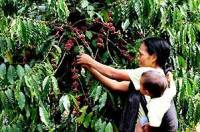
Mekonnen Leka, 78, takes a sip of his evening cup of coffee with
nearly 30 friends and neighbors who have gathered at his home
in Afeta, Ethiopia, February 13, 2007. As the elder, he gets the first cup.
(Wes Pope/Chicago Tribune/MCT)
by Colleen Mastony
Chicago Tribune (MCT)
2 April 2007
JIMMA, Ethiopia—Inside the coffee plant’s corrugated metal fence, men look more like mules as they lug 100-pound sacks of coffee on their backs.
But as midday nears, a heavenly scent wafts from the corner, where Ahmed Achoumeto, 25, pounds a pile of black coffee beans in preparation for the noontime break.
“I am terribly addicted. If I don’t get coffee, I can’t see properly,” he said, standing barefoot in the dirt, grinding the beans with a primitive 3-foot-long wooden pestle and a mortar made of a hollowed tree stump. “Almost everyone here is addicted.”
Ethiopia is the birthplace of coffee. And in this caffeine-addled corner of the world, coffee is a blessing and a curse swirled together in a cup.
Amid the lush hills and misty valleys, peasants endure bleak conditions and back-breaking labor to bring the beans to the world market. While nearly every worker detests the process—the picking, sorting, washing, shelling and drying—they are also hopelessly hooked on the sweet and delicate flavor of the black elixir.
Here, comfort comes from the very thing that causes so much pain: the little brown bean.
People sip the brew morning, noon and night, calling together large groups of friends and neighbors, burning incense while they roast the raw beans, brewing the drink in a black pot with a narrow spout and serving it in small handle-less cups. This is not a quick cup of joe, but a coffee ceremony - a slow, sensual process that soothes aching bodies and revives minds.
“Coffee is the backbone of our country,” said Frew Demeke, 40, a former official at the Coffee and Tea Development Authority, as he sipped a steaming cup in a local restaurant. Ethiopia is among the poorest countries in the world. But as another patron, noted, “even the smallest coffee shop has an espresso machine and milk frother.”
The coffee plant—a woody perennial evergreen shrub that can grow to 12 feet—was first cultivated in this region of southern Ethiopia.
The Arabica strain, which today accounts for at least 75 percent of the world’s production, originated in these green, rolling hills.
A popular legend dating to as early as the 8th Century claims that a shepherd discovered the coffee buzz when he noticed his goats rearing and bleating. The goats had just eaten the leaves and berries of a nearby bush, and so the shepherd tried some berries too. Feeling a strange euphoria, the shepherd ran to a nearby monastery to share his great find.
Thus, a global obsession was born. The monks began chewing coffee beans before lengthy prayer sessions, and the custom spread throughout Christian Ethiopia. Coffee traveled along spice routes to Yemen, Turkey and Europe. Along the way, someone began brewing the beans to make a hot drink.
Today, the French call it cafe and the Italians calls it caffe. Whatever the language, the word for coffee points to its birthplace: the ancient region of Ethiopia called Kaffa, a highland area with rich soil and cool temperatures that make for the perfect conditions to grow Coffea arabica.
In the central square in Jimma, one of the largest cities in the Kaffa region, a 6-foot decorative coffee cistern dominates the central square. A huge panoramic mural shows a woman picking coffee among the hillsides.
This is a breathtakingly beautiful place of low-hanging clouds and deep green hills. Groves of eucalyptus and banana trees line the winding roadsides. White trumpet flowers bloom around every corner. Baboons and black-and-white colobus monkeys frolic in the forests. Outside of town, coffee plants blanket the hillsides, growing under the shady canopy of acacia trees.
Little has changed over the centuries. People still live in mud huts, bathe in open streams and transport coffee on the backs of donkeys. And while people here don’t have much—there is no running water, and electricity arrived only recently—they do have coffee. Lots of coffee.
The plant accounts for more than 50 percent of Ethiopia’s exports, 95 percent of which is grown by small farmers. About 700,000 households are dependent on coffee, and another 15 million are partly dependent on coffee for their livelihoods, according to Oxfam, the British-based charity, which has worked to increase living standards for coffee workers around the globe.
On small family-owned farms, every hand is needed in the coffee harvest, which means that children as young as 4 years old will pick coffee with their families. The place is so tied to the little beans, that when coffee prices rise on the world market, thatched roofs on the mud huts here begin to disappear, as people can afford to replace their roofs with tin.
Every morning, just after sunrise, people walk the rough dirt roads toward the coffee processing plants—long, rustic buildings with corrugated metal roofs.
Inside, large shelling machines roar and belch clouds of dust. Dozens of women and girls—some as young as 12 years old—use large white pans to sift the beans, throwing them in the air in a continuous rhythmic action that fills the room with a shh-shh-shh sound like one hundred maracas shaking in unison. Dozens more crouch on the ground picking impurities from the beans. And every few minutes a barefoot man drags another bag of beans inside for processing. Outside, piles of coffee beans are spread on the ground to dry in the sun.
It is dreary, monotonous, exhausting work. But amid the burlap sacks and the rattling of beans, coffee peasants dream of a better life. Asegedch Malutu, 20—a beautiful woman crouched on a thin plastic mat to sort the beans—fantasizes about working in a shop. “Anything but this,” she said. Etensh Sisay, 16, a tall girl with big eyes, said she is so tired when she goes home, she immediately falls to sleep. When she closes her eyes, she said, she dreams of coffee.
Most of the factory workers are girls and women. Boys go to school, and men work in the fields. Aynalem Bekele, 14, in a Calvin Klein T-shirt and a bandanna around her head, sometimes wishes she were a boy because, she said, “they are free.”
The grueling process leaves the workers with little more than aching backs, stiff joints and—if they are lucky—$1.50 a day in wages. At the end of the day, the workers shuffle out of the factories and back to their houses. They gather together around the fire to take their share of comfort from the coffee.
In a rustic one-story house, with dirt floors, earthen walls and a papaya tree outside the door, nearly 30 friends and neighbors gather for their evening cup. Mekonnen Leka, 78, the half-blind and elderly homeowner, sits on a wooden stool, waiting for his daughter to make the coffee. “The smell, the taste, the feeling it gives you,” he said of the drink. “When we come home tired, it makes us strong.”
His daughter, Elfenesh Mekonnen, 33, tends a small charcoal fire in the center of the room. She roasts the green coffee beans on a metal pan until they turn dark and oily. The charcoal glows red and gives off a soft light. Smoke fills the room, which feels warm and cozy. On benches along the walls, people chat and take in the aroma.
She pours each cup with flourish, not spilling a drop. The first cup goes to Leka, the eldest in the room.
Everyone in the room watches as Leka brings the small cup to pursed lips. He blows on the coffee. And then he takes a sip. His whole body seems to relax. He smacks his lips and then smiles.
“Very good,” he says.
PERCOLATING MOMENTS
A.D. 850: Legend says, an Arab goat herder notices his goats acting strangely. He tastes berries of an evergreen bush where the goats feed and experiences the first official “coffee buzz.”
1600: Coffee spreads across Europe. In England, by the late 1600s, coffee supplants alcohol as a favorite breakfast drink.
1688: The largest insurer in the world, Lloyd’s of London, begins life as a coffeehouse.
1730: The British introduce coffee to Jamaica, where today one of the most expensive coffees in the world is grown in the Blue Mountains.
1800s: Coffee cultivation spreads to South and Central America and Hawaii.
1900: Luigi Bezzera invents espresso, introducing a pressure process that reduces brewing time. He calls his new machine the “Fast Coffee Machine.
1908: Invention of the world’s first drip coffeemaker.
1950s: Instant coffee is “perfected.”
1971: Starbucks opens, and within three decades the trendy coffee shops become a worldwide phenomenon.
Sources: World Book Encyclopedia, International Coffee Organization, and “Uncommon Grounds: The History of Coffee and How It Transformed Our World,” by Mark Pendergrast












